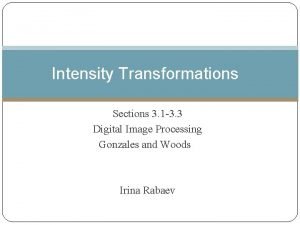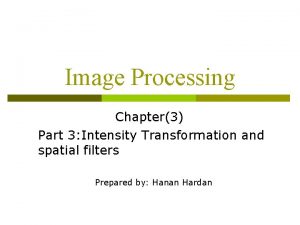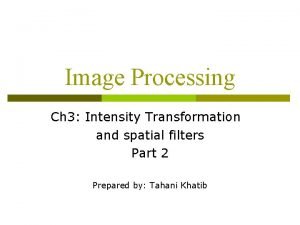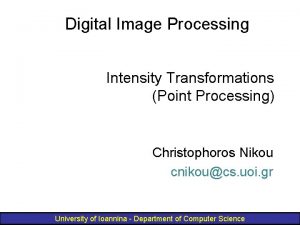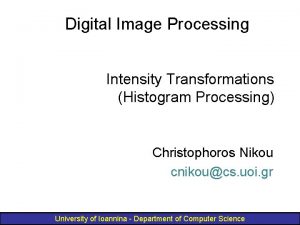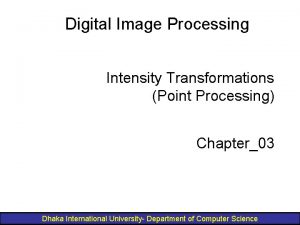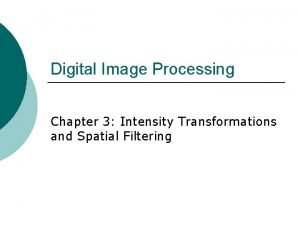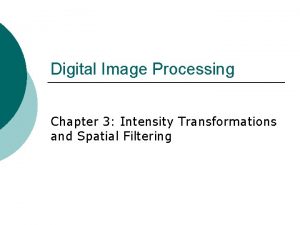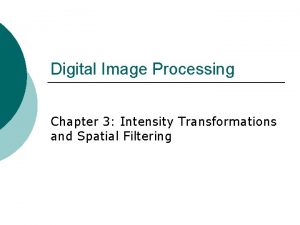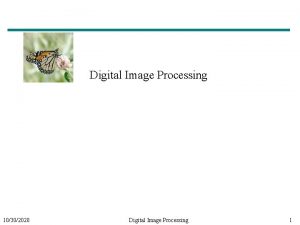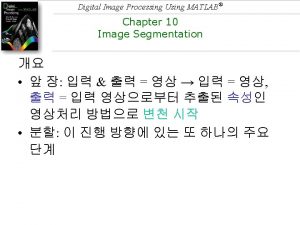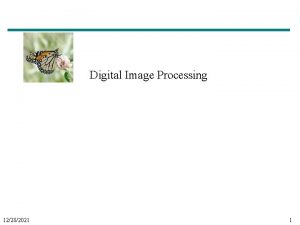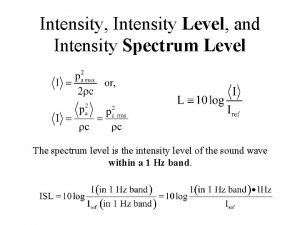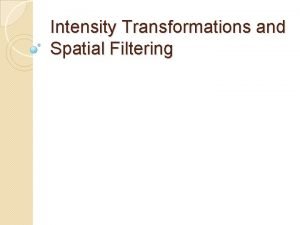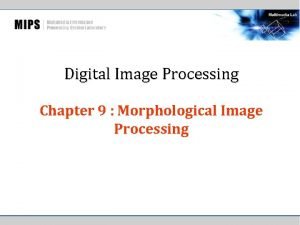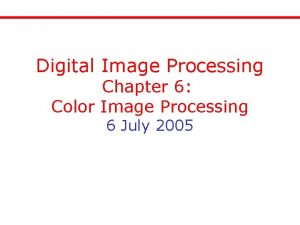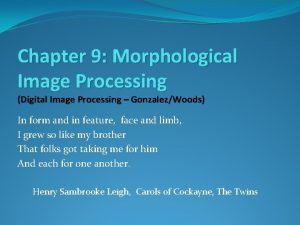Chapter 3 Digital Image Processing 2012 Intensity Transformations























- Slides: 23

Chapter 3 Digital Image Processing (2012) Intensity Transformations or Translation in Spatial Domain

What is Spatial Domain � The term spatial domain refers to the image plane itself. � Two principal categories of spatial processing: ◦ Intensity transformations: operates on single pixels of an image, for the purpose of contrast manipulation and image thresholding. ◦ Spatial filtering: deals with performing operations, such as, image sharpening, by working in the neighborhood of every pixel in image>

The basics of Intensity Transformation and Spatial Filtering: � All the image processing techniques discussed in this section are implemented in the spatial domain. � The spatial domain can be denoted by the expression: g(x, y) = T[f(x, y)] � Where f(x, y) is the input image, g(x, y) is the output image, and T is an operator on f defined over a neighborhood of point (x, y)

Intensity Transformation and Spatial Filtering

The smallest possible neighborhood is of size 1 x 1. in this case, g depends only on the value of f at a single point (x, y) and T becomes an intensity (also called gray-level or mapping) transformation function of the form: S = T(r)

� In this chapter intensity transformation is used for image enhancement and in chapter 10 it is used in image segmentation. � Most examples in this chapter are applications to image enhancement. � Enhancement: is the process of manipulating an image so that the result is more suitable than the original for a specific application. For example a method that is useful for enhancing X-ray images may not be useful for satellite images taken in the infrared band of the EM spectrum.

Basic Intensity Transformation Functions: � Image Negatives � Log Transformations � Power-Law (Gamma) Transformations � Piecewise-Linear Transformation Functions ◦ Contrast Stretching ◦ Intensity-level slicing ◦ Bit-Plane slicing � Histogram Processing Histogram Specification � Histogram Matching �

Image Negatives � � The negative of an image with intensity levels in the range [0, L-1] is obtained by using the negative transformation shown below, which is given by the expression: s = L-1 -r Revising the intensity levels of an image in this manner produces the equivalent of a photographic negative.

Image Negatives

Log Transformation � The general form of the log transformation is: s= clog(1+r); Where c is a constant, and it is assumed that r >=0. the shape of the log curve in figure 3. 3 shows that this transformation maps a narrow range of low intensity values in the input into a wider range of output levels. The opposite is true of higher values of input levels.

Power-law (Gamma) Transformations � Power-law form: transformations have the basic s = crϒ where c and ϒ are positive constants � As in the case of the log transformation, power-law curves with fractional values of ϒ map a narrow range of dark input values into a wider range of output values with the opposite being true for higher values of input levels.

Power-law (Gamma) Transformations Unlike the log function, however, we notice here a family of possible transformation curves obtained simply by varying ϒ.

Power-law (Gamma) Transformations � By convention, the exponent in the powerlaw equation is referred to as gamma. � The process used to correct these powerlaw response phenomena is called gamma correction.

Another example of Gamma Correction

� Piecewise-Linear Transformation Functions 1. Contrast Stretching 2. Intensity-level slicing 3. Bit-Plane slicing Contrast Stretching function: is one of the simplest piecewise linear functions. Law-contrast images can result from poor illumination, lack of the dynamic range in the imaging sensor, or even the wrong setting of the lens aperture during image acquisition. Contrast Stretching: is a process that expands the range of intensity levels in an image.

Contrast Stretching Transformations

Contrast Stretching � � � Figure 3. 10(a) shows a typical transformation used for contrast stretching. The locations of (r 1, s 1) and (r 2, s 2) control the shape of the transformation function. If r 1=s 1 and r 2=s 2, the transformation is a linear function that produces no changes in intensity levels. If r 1=r 2, s 1=0, s 2=L-1, the transformation becomes a thresholding function that creates a binary image as in Fig. 3. 2(b). Intermediate values of (r 1, s 1) and (r 2, s 2) produce various degrees of spread in the intensity levels of the out put image, thus affecting its contrast.

Intensity-level slicing � Highlighting a specific range if intensities in an image often is of interest. � Applications that use it: enhancing features such as masses of water in satellite imagery and flaws (errors) in X-ray images. � Has two approaches: ◦ First approach: display two values (black and white). Lets say all values in the range of interest is white and all other values is black as show in Fig. 3. 11(a). ◦ Second approach: based on transformation in Fig. 3. 11(b), brightens or (darkens) the desired range of intensities, but leaves all other intensity levels in the image unchanged.

Intensity-level slicing

Intensity-level slicing � Figure 3. 12(a) shows an aortic angiogram near the kidney area. The objective of this example is to use the intensity-level slicing to highlight the major blood vessels that appear brighter.

Bit-Plane slicing � � Pixels are digital numbers composed of bits. For example, the intensity of each pixel in a 256 -level gray-scale image is composed of 8 -bits (i. e. one byte). Instead of highlighting intensity-level ranges, we could highlight the contribution made to total image appearance by specific bits. As Fig. 3. 13 illustrates, an 8 -bit image may be considered as being composed of eight 1 -bit planes, with plane 1 containing the lowest order bit of all pixels in the image and plane 8 all the highest-order bits.

Bit-Plane slicing � Figure 3. 14(a) shows an 8 -bit gray scale image. � Figs. 3. 14(b) through (i) are its eight 1 -bit planes, with Fig. 3. 14(b) corresponding to the lowest-order bit. � Observe that the four higher-order bit planes, especially the last tow, contain significant amount of the visually significant data. � The lower-order planes contribute to more suitable intensity details in the image.

Bit-Plane slicing
 Basic intensity transformation in digital image processing
Basic intensity transformation in digital image processing Power-law (gamma) transformations
Power-law (gamma) transformations Intensity level slicing in image processing
Intensity level slicing in image processing Intensity transformation in digital image processing
Intensity transformation in digital image processing Histogram processing in digital image processing
Histogram processing in digital image processing Neighborhood processing in image processing
Neighborhood processing in image processing A generalization of unsharp masking is
A generalization of unsharp masking is Image processing
Image processing Point processing
Point processing Gonzalez
Gonzalez Translate
Translate Linear position invariant degradation
Linear position invariant degradation Arithmetic coding in digital image processing
Arithmetic coding in digital image processing Key stage in digital image processing
Key stage in digital image processing Fidelity criteria in image compression
Fidelity criteria in image compression Image sharpening in digital image processing
Image sharpening in digital image processing Geometric transformation in digital image processing
Geometric transformation in digital image processing Digital image processing diagram
Digital image processing diagram Walsh transform in digital image processing
Walsh transform in digital image processing Imtransform matlab
Imtransform matlab Noise
Noise Intensity transformations
Intensity transformations Doterra taiwan
Doterra taiwan Intensity transformations and spatial filtering
Intensity transformations and spatial filtering

